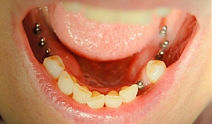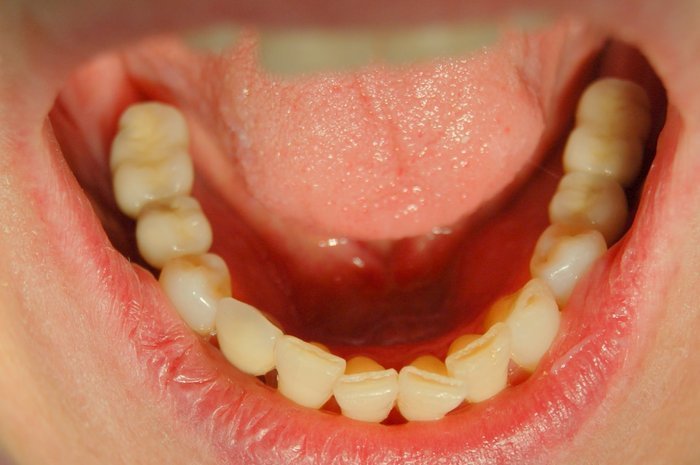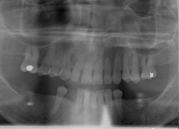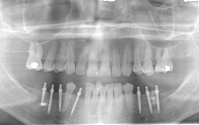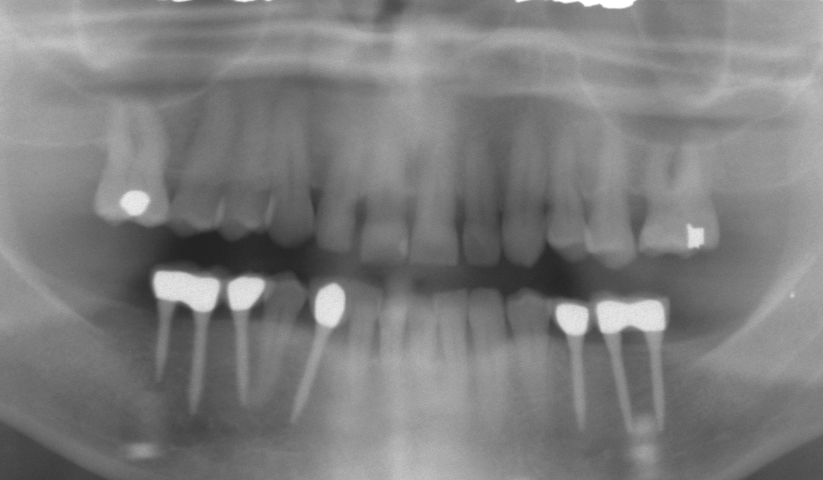Dental Implants
These are our own patients and not taken from a manufacturers website. We place and restore our own implants. Please scroll all the way to the bottom of the page to have your questions answered. Nothing on this page may be duplicated without our express written permission.
Amazing Implant Story
Dental Implant Dentist Procedure: Advantages, Success Rate, and Costs
Why your office?
-Clinically proven results with multiple photos of all types on our website (Dr. Brower trains and lectures to other general dentists in placement of implants) He is a recognized expert in the field. As a dental implant dentist he enjoys placing mini dental implants and new technology implants.
-Decreased cost due to our high volume of implants placed and doing the work as general dentists which doesn’t make us count on patients being referred to us. We offer the most affordable dental implants in Siouxland. Our mini dental implant price for dentures is under $1000!!
-Most cutting edge technology available with incisionless techniques for placing implants that allow us to use our implants the day they are placed.
Implant Information?
If you are missing one or more teeth, you’ll want replacements that are as natural as possible. If dentures or fixed bridgework doesn’t seem like a good idea, you may consider dental implants. Unlike dentures, which can be removed, implants are permanently anchored into the jaw itself.
Losing a tooth by accident or by extraction is not the end of the matter. When a tooth is missing, the resulting gap will allow nearby teeth to tilt or drift from their normal position, and the teeth above the gap will move downward. Aside from the obvious cosmetic problem, the changed positions of these teeth can lead to severe bite problems causing jaw pain and headaches.
You are a good candidate for implants if you have jawbone ridges that are in good shape and healthy oral tissues. When the implant device is inserted into the jaw, a chemical and mechanical bond is formed. The jawbone actually grows into the implant.
Missing teeth should be replaced to keep other teeth in their normal position. This can be done by means of a fixed bridge or a dental implant. Both of these treatments offer a good functional and cosmetic result.
A dental implant is a titanium metal replacement for a root of a tooth that is surgically implanted in the jawbone.
As the body heals for approximately two to six months after the surgery, the bone around the implant fuses to the implant through a process called osseointegration with some older forms of implants. In our office many of the implants we place can be used immediately without expensive bone grafting for under $1000.
After the healing phase is complete, the implants are used to anchor crowns, bridges, or dentures.
The process should begin with a thorough evaluation of the patient’s medical and dental history, and a full clinical examination of the entire mouth and missing tooth area. The clinical exam should also include specific X-rays.
After assessing the patient, a comprehensive treatment plan can be devised. From that point, implants are surgically placed in the jawbone under local anesthesia.
Many people wonder how many implants are necessary to replace their missing teeth. This is a question that should be determined during the treatment plan. A good rule-of-thumb is to place one implant for each tooth replaced. One posterior teeth with mini dental implants 1 implant is placed for each main root missing on a molar. Molar teeth require 2 implants, and all other teeth require 1 implant. Other decisive factors for the number of implants needed for success is the quality and quantity of the patient’s bone. Equally as important are the existing anatomy of the bone and the financial resources of the patient.
When considering Stabilizing your denture with implants we typically place 4 implants in the lower jaw to lock the denture to it, and 6 in the upper jaw. These implants are always used immediately and cost under $1000 each. You can arrive in the morning and eat corn on the cob and apples for lunch after having implants lock your denture in!
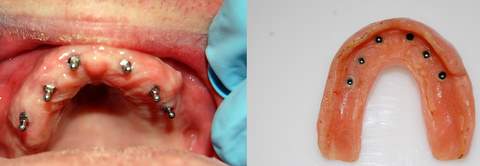
When getting dental implants, you should select a dentist or dental team with in-depth knowledge and prior experience with all aspects of the treatment. We have placed and restored implants for both dentures and crowns successfully for years and are proud to display our cases to show you the results! Most likely we can show you a photo of an exact case like you would present to us so that you can see what would happen. Please ask during your free consultation for this if you are interested.
It is important to know that implant treatment consists of two components: a surgical phase and a restorative phase. Mini Dental implants used to restore crowns and dentures from IMTEC are FDA approved for immediate loading in long term use situations. All of the implant brands, sytems, and types we use are FDA approved. We do not limit ourselves to one brand or type of implant. Every system has advantages and disadvantages and we choose the correct one for each case for the best result without changing our price.
Traditionally, a dental surgeon, like an oral surgeon or a periodontist, performs the surgical component. A general dentist, or prosthodontist and laboratory technician performs the restorative component. However, as implant dentistry has become more sophisticated, sometimes a dentist who specializes in restorative dentistry conducts the entire procedure. By both placing and restoring the implant at one location with one doctor better results can be achieved.
Are there different types of dental implants?

Yes, several types are available. The American Dental Association considers both the endosteal and the subperiosteal implants to be acceptable.
An important factor for selection is to determine whether your jawbone can adequately support the implant. Most dental implants placed today are endosteal root form fixtures (similar to a man-made tooth root). We place all forms of implants including mini dental implants that are approved for immediate loading by the FDA. This mini implant was put in in 1969 and was still functioning 20 years later! You can see the natural teeth didn’t last as long.
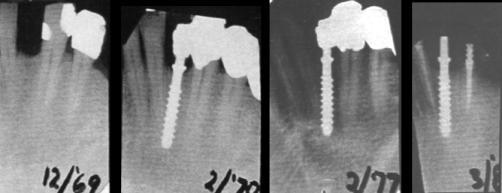
The Dental Implant Procedure
Today’s dental implants are virtually indistinguishable from other teeth. This appearance is aided in part by the structural and functional connection between the dental implant and the living bone. Implants are typically placed in a single sitting but require a period of osseointegration.
Osseointegration is the process by which direct anchorage of a dental implant root and the bone of the jaw occurs. Osseointegrated implants are the most commonly used and successful type of dental implant. An osseointegrated implant takes anywhere from three to six months to anchor and heal, at which point your dentist can complete the procedure with the placement of a crown. Once the implant has anchored with the jawbone, artificial prosthesis may be attached and the process is done. If osseointegration does not occur, the implant will fail.
Detailed procedural steps are as follows:
Preparing the Jaw for Implantation: A dental implant is commonly composed of a titanium material screw and a crown. A small-diameter hole (pilot hole) is drilled at edentulous (where there is no tooth) jaw sites in order to guide the titanium screw that holds a dental implant in place. To avoid damaging vital jaw and face structures like the inferior alveolar nerve in the mandible (lower jaw), a dentist must use great skill and expertise when boring the pilot hole and sizing the jaw bone.
Placement of the Implant: After the initial pilot hole has been drilled into the appropriate jaw site, it is slowly widened to allow for placement of the implant screw. Following this placement, a protective cover screw is placed on top to allow the implant site to heal and the dental implant to anchor (osseointegration). After several months, the protective cover is removed and a temporary crown is placed on top of the dental implant. The temporary crown serves as a template around which the gum grows and shapes itself in a natural way. The process is completed when the temporary crown is replaced with a permanent crown.
Success Rates of Dental Implants
Dental implants are among the most successful procedures in dentistry. There is no guarantee that an implant procedure will be successful, but studies have shown a five-year success rate of 95% for lower jaw implants and 90% for upper jaw implants. The success rate for upper jaw implants is slightly lower because the upper jaw (especially the posterior section) is less dense than the lower jaw, making successful implantation and osseointegration potentially more difficult to achieve. Lower posterior implantation has the highest success rate for all dental implants.
Dental implants may fail for a number of reasons. The cause is often related to a failure in the osseointegration process. For example, if the implant is placed in a poor position, osseointegration may not take place. Dental implants may break or become infected (like natural teeth) and crowns may become loose.
If you are a smoker who is considering a dental implant, your dentist will likely advise you to give up smoking before undergoing the process because smokers face a higher risk of implant failure. Since the procedure can be extremely expensive, you risk wasting your money on dental implants if you do not give up the habit.
On the plus side, dental implants are not susceptible to the formation of cavities; still, poor oral hygiene can lead to the development of peri-implantitis around dental implants. This disease is tantamount to the development of periodontitis (severe gum disease) around a natural tooth.
Why are yours so affordable? What is the cost of dental implants? Why choose you when many people offer implants?
Every surgeon may set their own individual fees for a particular procedure. The cost of the implants from the manufacturers to the practitioner is the same for a single implant, but when buying large quantities of implants they significantly reduce the cost of the implants to the practitioner. We have a significantly reduced fee for our implants of under $1000 to a maximum of $1550 for implants for crowns per implant compared to a traditional fee which is much higher because we are purchasing implants in larger volumes to keep up with the number we place. As general dentists we also create the crown or cap that will go on top of the implant and the fee associated with that helps offset the reduced cost we charge for the implants. Simply put, we are passing on the savings to you by doing a larger volume and keeping the work in house. When a patient is referred out to a “specialist”, the specialist traditionally will have to order in the particular brand and size of implant that will be adequate for the site of the patient that is presented to them. It is impossible for them to know what will be presented to them in advance, so it would be very cost prohibitive to stock every brand and size of implant “in case” that patient arrived. Most have a set brand and certain sizes on hand, but as a specialist they traditionally will get the unusual cases or very difficult cases that do not lend themselves to normal situations. Fortunately what we have found in our clinic is that over 95% of implant placement is in normal locations in normal situations that do not require extreme bone grafting, specialized implants, or specialized placements. Placement and restoration is as routine as getting a filling in 95% of the cases for us!
Our denture package is $7500 and very popular. It provides a discount for tooth removals that limit the fee to $100 each, and a discount for bone grafting each of the tooth removals to $100 each. This includes a provisional immediate denture and the dental implants needed to support the denture which are usually placed at the same time. Future dentures and prosthetics are sometimes needed since these are immediate dentures and are not included. You may also choose to have “No More Dentures” and go to a hybrid appliance made out of PMMA or Porcelain which we remove for you at your 3 month cleanings which we want you to schedule with us so we can continue to monitor the health of the implants and prosthetics.
Full arch Implant pricing per jaw including different prosthetics
All cases include one try in (unless fabricated chairside) or temporary. Additional temporaries or try ins are at an additional cost of 1500 per jaw. Adjustments are included. Breakage of temporaries that require a remake are performed at 750 to 1500 each depending upon material and complexity. Determination of the number of implants needed is case specific and varies dramatically from one patient to the next based on their function and needs. It is determined after a free consultation and inquiry into the patients expectations.
Options:
Denture packages
7500- Removable daily by the patient for cleaning.
1 immediate denture plus implants to support the denture. Up to 6 total, and usually mini implants. If sufficient support is available the upper can be made into a horseshoe shape giving back speech and taste. A separate final denture may be required at additional cost.
12500- Removable by the patient for cleaning.
6 or more implants per jaw with reinforced denture or long term plastic tooth shaped prosthetic shaped like horseshoe.
If patient compliance isn’t sufficient and/or oral hygiene is poor during treatment cleanings at each visit are included as well as implant removal(s) if required. Treatment will not progress to a nonremovable prosthetic and the additional time and costs associated with compliance are charged out to the final prosthetic and implant cost paid to adjust for the additional time and complexity required to deal with a noncompliant patient. A different temporary (1) and final removable prosthetic (1) are fabricated as needed instead at no cost additional to the case and provided to the patient in exchange of costs paid up to 25000 per jaw.
Future retreatment is possible at additional cost, but will need to include specialist care of tissue and prosthetics for collaboration.
17500- Removable by the dental office for cleanings if needed, and cleaned at home without removal by the patient.
4 implants screwed to plastic denture (does not include grafting)
6 implants with oballs attached to porcelain prosthetic (does not include grafting)
Non Denture packages
22500- Removable by the dental office for cleanings if needed, and cleaned at home without removal by the patient
2 more implants added to the previous option ( may be mini or conventional implants using oballs) does not include grafting.
25000- Removable by the dental office if needed for cleanings, and cleaned at home without removal by the patient
4 implants screwed to porcelain prosthetic. Each additional implant adds 1500 additional cost and includes addition to the prosthetic. Does not include grafting.
6 or more implants cemented to implants like real teeth and cleaned like real teeth with a porcelain prosthetic. Does not include grafting.
Grafting is not a guarantee of success, or a guarantee against failure.
Patient compliance/following of recommendations and guidelines are by far the most important factor in case success and longevity.
Tell us your story and see if you qualify for a quality of life discount.
What can be done for a single missing tooth?
In the case of a single missing tooth, a dental implant can be placed in the jawbone area of the missing tooth. The implant will serve as a replacement for a tooth root and an individual crown. Unlike traditional implants these implants are placed and frequently restored in one visit.
Once in place, the implant crown will look, feel, and function like a natural tooth. They are cleaned and flossed just like natural teeth, and best of all, they do not require any special tools to clean around them like bridges. Although dental implants will not decay, they require impeccable oral hygiene.
Video Below
The following video shows how Dr. Brower is trained to immediately load the implants without incisions from someone with a denture. Not all Doctors are trained to do implants without incisions with is far better for patient comfort and decreased chance of infection for the patient.
